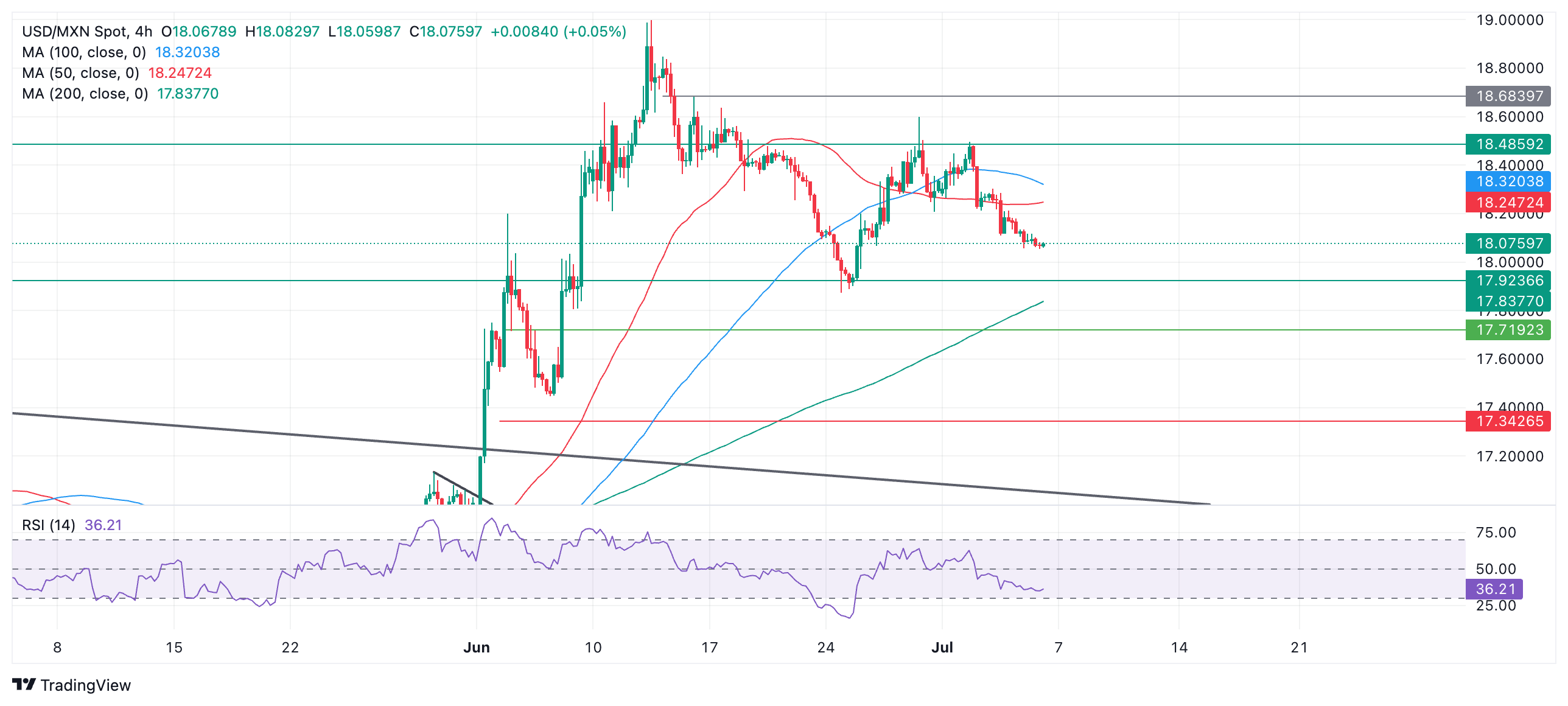Mexican Peso rises for fourth day in a row against USD
- The Mexican Peso continues rallying against the US Dollar and makes more muted gains against European counterparts.
- The Greenback is losing ground after a run of weak US economic data.
- In Europe, political risk eases, taking pressure off the Euro and the Pound.
The Mexican Peso (MXN) continues drifting higher in its most traded pairs on Friday, with gains particularly marked against the US Dollar (USD), which has weakened after a run of poor US economic data. In Europe, the Peso’s gains are more muted due to reduced political risk as elections indicate moderates holding onto power despite the rise of the far-right.
MXN gains a further boost after comments from the Deputy Governor of the Bank of Mexico (Banxico), Jonathan Heath, who said he was skeptical about interest rates falling in Mexico in the near term, comparing his stance to that of Federal Reserve (Fed) Chairman Jerome Powell.
At the time of writing, one US Dollar (USD) buys 18.07 Mexican Pesos, EUR/MXN trades at 19.57, and GBP/MXN at 23.09.
Mexican Peso rises against USD
The Mexican Peso is rising against the US Dollar for the fourth day in a row as traders digest the recent run of weak US economic data and its implications for interest rates going forward, a key driver of FX flows.
The hitherto buoyant services sector showed signs of contraction on Wednesday after ISM Services Purchasing Managers Index (PMI) data came out at 48.8, falling below the 50 level that separates growth from contraction and its lowest level since 2020.
US Jobs data showed signs of a cooling job market with Initial Jobless Claims rising and Continuing Claims hitting 1.858 million in the week ending June 22, its highest since November 2021. Investors now await June’s data for US Nonfarm Payrolls on Friday, a key data point that could further shape expectations on interest rates.
The upshot of it all is a weaker USD, as falling inflation expectations will make the Fed more inclined to cut interest rates, and lower interest rates are negative for the Dollar as they attract less foreign capital inflows.
Mexican Peso’s gains muted versus European counterparts
The Mexican Peso is making fewer gains against the Euro (EUR) and the Pound Sterling (GBP) due to easing political risk. It now seems likely that the far-right French National Rally (RN) party will not get enough seats for a majority in the second round of French elections on Sunday, which, in turn, supports the Euro.
Across the channel, meanwhile, the Pound Sterling (GBP) has been lifted slightly after the Labour Party’s landslide victory in Thursday’s general election. Some analysts have cited a more stable political climate, as well as stronger prospects for growth, as key drivers for expecting some post-election strengthening in GBP.
Technical Analysis: USD/MXN continues sliding to key low
USD/MXN continues edging lower towards the key June 24 swing low at 17.87. It is possible the pair is entering a sideways trend, although it is still a little too early to be sure.
USD/MXN 4-hour Chart

There is a chance that once the June 24 low is achieved, the pair will begin to consolidate. If it begins a leg higher, it could be a sign that the pair is entering a sideways trend. Alternatively, a decisive break below 17.87 would likely suggest a new downtrend, with the next target lying at 17.50 (50-day Simple Moving Average).
A rally back above 18.59, however, would suggest a continuation up to 18.68 (June 14 high), followed by 19.00 (June 12 high). A break above 19.00 would provide strong confirmation of a resumption of the short-and-intermediate term uptrends.
The direction of the long-term trend remains in doubt.
Economic Indicator
Nonfarm Payrolls
The Nonfarm Payrolls release presents the number of new jobs created in the US during the previous month in all non-agricultural businesses; it is released by the US Bureau of Labor Statistics (BLS). The monthly changes in payrolls can be extremely volatile. The number is also subject to strong reviews, which can also trigger volatility in the Forex board. Generally speaking, a high reading is seen as bullish for the US Dollar (USD), while a low reading is seen as bearish, although previous months' reviews and the Unemployment Rate are as relevant as the headline figure. The market's reaction, therefore, depends on how the market assesses all the data contained in the BLS report as a whole.
Read more.Next release: Fri Jul 05, 2024 12:30
Frequency: Monthly
Consensus: 190K
Previous: 272K
Source: US Bureau of Labor Statistics
America’s monthly jobs report is considered the most important economic indicator for forex traders. Released on the first Friday following the reported month, the change in the number of positions is closely correlated with the overall performance of the economy and is monitored by policymakers. Full employment is one of the Federal Reserve’s mandates and it considers developments in the labor market when setting its policies, thus impacting currencies. Despite several leading indicators shaping estimates, Nonfarm Payrolls tend to surprise markets and trigger substantial volatility. Actual figures beating the consensus tend to be USD bullish.
